剪不断家乡情——山西老陈醋英文介绍
关于山西老陈醋的英语作文
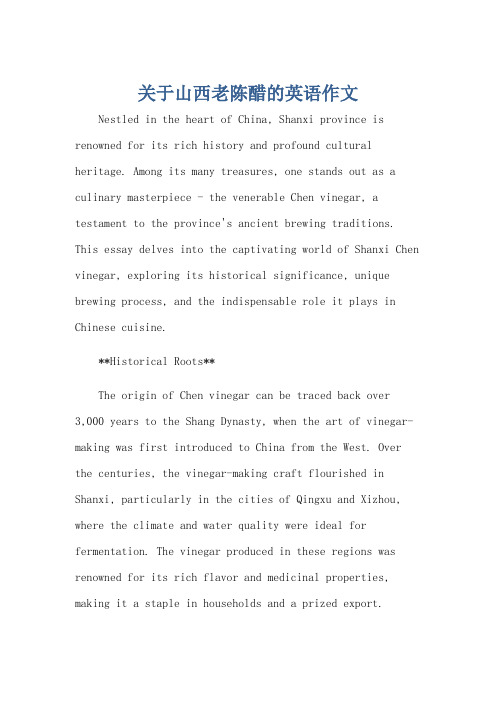
关于山西老陈醋的英语作文Nestled in the heart of China, Shanxi province is renowned for its rich history and profound cultural heritage. Among its many treasures, one stands out as a culinary masterpiece - the venerable Chen vinegar, a testament to the province's ancient brewing traditions. This essay delves into the captivating world of Shanxi Chen vinegar, exploring its historical significance, unique brewing process, and the indispensable role it plays in Chinese cuisine.**Historical Roots**The origin of Chen vinegar can be traced back over3,000 years to the Shang Dynasty, when the art of vinegar-making was first introduced to China from the West. Over the centuries, the vinegar-making craft flourished in Shanxi, particularly in the cities of Qingxu and Xizhou, where the climate and water quality were ideal for fermentation. The vinegar produced in these regions was renowned for its rich flavor and medicinal properties, making it a staple in households and a prized export.**The Brewing Process**The brewing of Chen vinegar is a meticulous and time-honored process. It begins with the selection of high-quality grains, primarily wheat and glutinous rice, which are then mixed with water and allowed to ferment. This fermentation process, known as "souring," converts the starches in the grains into sugars, which are then converted into alcohol by yeast. The resulting liquor is then aged in wooden barrels for up to several years, allowing it to mature and develop its unique flavor.During this aging process, the vinegar acquires its characteristic amber hue and robust aroma. The barrels, made of oak or pine, contribute to the vinegar's flavor by allowing for the slow evaporation of water and the absorption of trace elements from the wood. The aging process also allows for the development of complex flavor compounds, giving Chen vinegar its distinctive taste profile.**Culinary Applications**Chen vinegar is an indispensable ingredient in Chinese cuisine, especially in the northern regions where itoriginated. It is used in a wide range of dishes, from salads and pickles to marinades and sauces. Its unique flavor, which is both sour and slightly sweet, enhances the taste of food while adding a layer of complexity. Chen vinegar is also believed to have health benefits, including aiding in digestion and improving blood circulation.**Conclusion**Shanxi Chen vinegar is a testament to the rich brewing traditions of China. Its unique brewing process and distinctive flavor have made it a cultural icon and a culinary staple. As we delve deeper into the world of Chinese cuisine, it is the vinegar that ties together the flavors and histories of the past, present, and future. Shanxi Chen vinegar is not just a condiment; it is a bridge between generations and a symbol of China's enduring culinary heritage.**山西老陈醋的精髓**位于中国心脏地带的山西省,以其丰富的历史和深厚的文化底蕴而闻名。
介绍山西特产英文作文
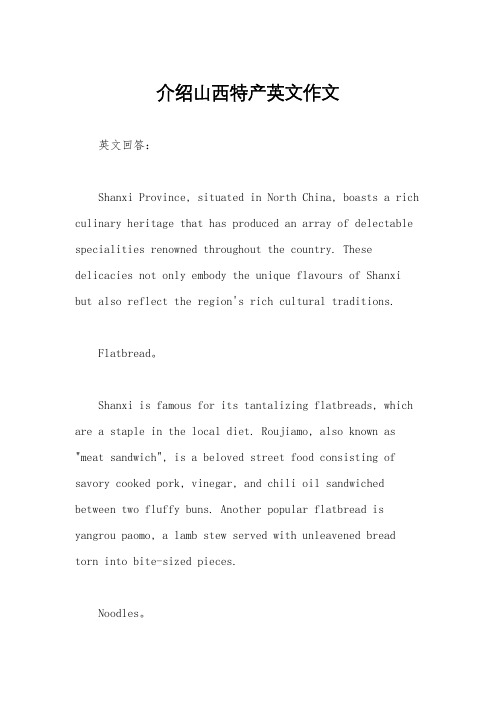
介绍山西特产英文作文英文回答:Shanxi Province, situated in North China, boasts a rich culinary heritage that has produced an array of delectable specialities renowned throughout the country. These delicacies not only embody the unique flavours of Shanxi but also reflect the region's rich cultural traditions.Flatbread。
Shanxi is famous for its tantalizing flatbreads, which are a staple in the local diet. Roujiamo, also known as "meat sandwich", is a beloved street food consisting of savory cooked pork, vinegar, and chili oil sandwiched between two fluffy buns. Another popular flatbread is yangrou paomo, a lamb stew served with unleavened bread torn into bite-sized pieces.Noodles。
Shanxi is a noodle-lover's paradise, with a vastvariety of handmade noodle dishes. Dao shao mian, or knife-cut noodles, are wide, flat noodles traditionally made with a special knife. They are often served in a hearty brothwith various toppings such as sliced meat, vegetables, and chili oil. Another favourite noodle dish is biangbiang mian, named after the onomatopoeic sound of the dough being slapped against the counter during preparation. These noodles are wide and flat, often served with a spicy sauce and a variety of toppings.Vinegar。
介绍家乡山西的英语作文(通用8篇)
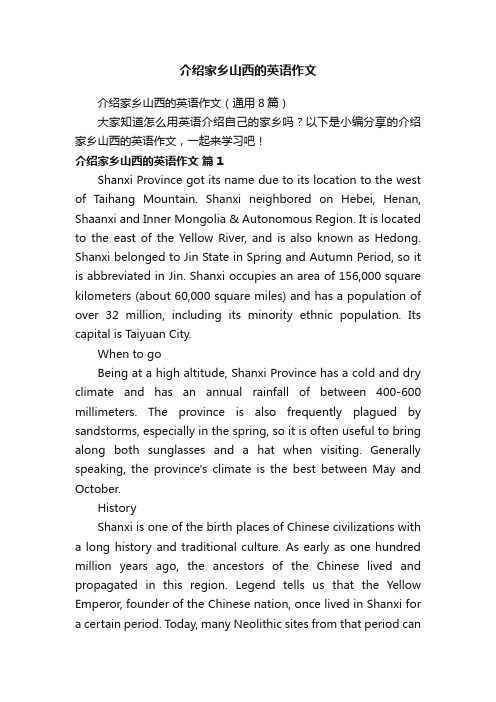
介绍家乡山西的英语作文介绍家乡山西的英语作文(通用8篇)大家知道怎么用英语介绍自己的家乡吗?以下是小编分享的介绍家乡山西的英语作文,一起来学习吧!介绍家乡山西的英语作文篇1Shanxi Province got its name due to its location to the west of Taihang Mountain. Shanxi neighbored on Hebei, Henan, Shaanxi and Inner Mongolia & Autonomous Region. It is located to the east of the Yellow River, and is also known as Hedong. Shanxi belonged to Jin State in Spring and Autumn Period, so it is abbreviated in Jin. Shanxi occupies an area of 156,000 square kilometers (about 60,000 square miles) and has a population of over 32 million, including its minority ethnic population. Its capital is Taiyuan City.When to goBeing at a high altitude, Shanxi Province has a cold and dry climate and has an annual rainfall of between 400-600 millimeters. The province is also frequently plagued by sandstorms, especially in the spring, so it is often useful to bring along both sunglasses and a hat when visiting. Generally speaking, the province's climate is the best between May and October.HistoryShanxi is one of the birth places of Chinese civilizations with a long history and traditional culture. As early as one hundred million years ago, the ancestors of the Chinese lived and propagated in this region. Legend tells us that the Yellow Emperor, founder of the Chinese nation, once lived in Shanxi for a certain period. Today, many Neolithic sites from that period canstill be seen dotted across the vast expanse of the province.What to seeShanxi is endowed with an abundance of cultural sites from its long history. Most of the ancient structures were built before the Liao and Song Dynasties. So it is the reason why Shanxi is often called the 'Chinese Ancient Architecture Museum'. The more obvious of these include: the Buddhist wonder of the Yungang Grottoes in Datong City, the ancient city of Pingyao which was listed as a World Cultural Heritage site by UNESCO in 1997, the oldest and tallest ancient wooden pagoda in China, the Wooden Pagoda of Yingxian County and the remote Shuanglin and Jinci Temples, which are well worth the long journeys for the visitors.Of course, there are a number of natural magnificent and beautiful places that can also be seen in Shanxi. The most famous of them include Wutai Mountain with the longest and most prestigious history in the four most well-known Buddhist holy lands of China, the whistling rage of the Yellow River's Kettle Spout waterfalls (Hukou Waterfalls) and one of the Five Sacred Mountains in China - Mt Hengshan.介绍家乡山西的英语作文篇2Taiyuan, the capital of Shanxi Province, is bounded on three sides by mountains. It has a 2500-year history and in ancient times was an important military town. Now Taiyuan is one of China's heavy industrial cities and accounts for more than half the national coal mining output.Taiyuan also has a wealth of tourist attractions and notably among these is the Jinci Temple. This is the city's most attractive temple although the Shuangta Si (Twin-Pagoda Temple) has become a symbol of Taiyuan on account of its unique architecture.Another major attraction is the Tianlong Shan Stone Caves where magnificent sculptures dating from the Tang Dynasty (618-907) may be seen.Taiyuan benefits from convenient public transport systems as the city is the provincial transportation hub. Accommodation facilities have become more and more advanced over recent years and range from 5-star hotels to a selection of comfortable guest houses.The gourmand should be aware that Shanxi noodles are highly reputed all over China, as well as the local vinegar. Other local delicacies are the Tou Nao, the Steamed Dumpling, Sausages and Mutton Soup. T o accompany these wholesome foods there are Fen Jiu (Fen Wine) and Zhuye Qing (Zhuye Qing Wine). As well as its cuisine the city is noted for products such as finely crafted lacquer ware.介绍家乡山西的英语作文篇3My home village is a small one. It’s in Yuxian county of Shanxi Province. Small as it is,it’s very beautiful.There are many hills around my home village and they are more beautiful than some big mountains. In spring, we can fly kites which are made by ourselves on the top of the hills. The kites fly very high.In summer, the trees are green and the grass is green, too. It is green everywhere on the hills. There are so many wild apple trees on the hills. The wild apples are nice to eat. In autumn, the corns under and around the hills are ripe. So we eat them almost every day. In winter, when it snows, all the ground is covered with snow. We can play with snow and sometimes we eat the clean snow with sugar. In my hometown the sky is blue,the air is clean,the water is sweet and the people are very friendly. I love my hometown!介绍家乡山西的英语作文篇4My hometown which is in the south of shanxi Province is a very beautiful village. It lies on the east bank of a small river surrounded by green mountains In the past my hometown was poor and people led a hard life.They couldnt afford to send their children to school. But great changes have taken place in my hometown in the past twenty years. Many families .have not only color TV sets but also telephones fridges computers and so on. New roads houses schools hospitals have been built. People in my hometown are working hard for a better life.介绍家乡山西的英语作文篇5As everyone knows that China is one of the most beautiful Countries all over the world. It is really famous for its long history and civilizations. As a Chinese girl I’m so proud of my Country. And of course I love it deeply in my heart. not just because it’s my hometown.Daqing is beautiful and modern. Thescenery here is so attractive. Everyone will love it at the fist sight.When you come to Daqing you will see museums parks and shopping centers here and there. wherever you go you can see green trees grass and beautiful flowers. what’s morethere are many places of historic interest in Daqing. Such as Iron Man Memorial Museum Children's Park Times square and the wetland tourism Taikang. I am sure that the beautiful scenery will attract more people to come here.Daqing is also famous for its oil. It provides oil for our Country. Thus it is an important city in China. I am proud of it.I also love the spirit of Daqing-the Iron Man Wang Jinxi Spirit.Wang Jinxi is a hero of Daqing. I learn a lot from him. Workhard! Persevere! And never give up!That is my hometown Daqing. I love it very much! I hope you love it as I do.Thank you everyone!介绍家乡山西的英语作文篇6Taiyuan is a historic city, Gu Cheng Jinyang, was founded in about 497 BC, for the early capital of the Zhao. In 246 BC, Qin Shi Huang at the world for 36 counties, Taiyuan County home early, from the start of T aiyuan said. After the Northern Dynasties, Sui and Tang period, the city of Taiyuan has been for ages. In the Five Dynasties, has for the Hou Jin Yang, Han, the North's capital of Seoul. In 960 AD, Zhao Kuangyin to overthrow the Later Zhou Dynasty, the establishment of the Northern Song Dynasty, sent his brother Zhao Guangyi in the year 979 years to capture Jinyang, set fire to the city, the city reduced to ashes generation. In 982 AD, Zhao Guangyi and Pamela reconstruction will be assigned to the Department of Taiyuan City. It was not until early in this warlord Yan Xishan rule of Shanxi, Taiyuan, in order to the capital, and down more than two thousand years, the ancient city of Taiyuan, after the war, repeatedly replacement. April 24, 1949, the Chinese People's Liberation Army to capture Taiyuan before the end, the ancient city back to the hands of the people, then on to obtain a new lease on life. In the long history, Taiyuan, has developed its famous handicraft industry and commerce. As early as the Tang and Song period, Taiyuan, has become a more developed cities in the handicraft industry. Taiyuan Ceramics of the Song Dynasty, 'grain porcelain patterns' unique in the country. After the Yuan Dynasty, Taiyuan, the country's arms manufacturing center. Tang, Song, Taiyuan, the business has developed rapidly. Especially in the Ming Dynasty, when theTaiyuan major Nanguan workshops, shops spread all over, unprecedented, the ancients had 'Bi Tian Guang, the vein to' praise.介绍家乡山西的英语作文篇7At present more and more students chase stars,especially many middle school students.When it comes the problem of star-worshipping,people hold the different ideas. Some people agreewith star-worshipping. There are many reasons.Firstly, it's fashionable for students to discuss stars'things among their classmates. Secondly, they canrealize more culture. Thirdly, they can study stars'advantages and achieve our own aim extremelyhard. However, others are against the idea above.They think that star-worshipping costs a lot of moneyand time. They blindly worship easily and lose direction. They coda imitate stars and easilyget bad habit. Even, they waste school work.In my opinion, star-worshipping is a bad thing. Tow reasons can explain my idea. On the onehand, we spend a lot of afford to understand the stars' entertainment news. On the otherhand. It affects our study. After all, it's very important for us to have our own career. In a word,we must have a rational way to worship star .介绍家乡山西的英语作文篇8How to effectively arrange working hoursFor an employee, how to arrange your work time effectively is the important key to decide whether you can get success or not. The word “effectively”, means you should do a lot of work and make it perfect in limited time. Make use of the most of your work time.We can set an example, when you enter or are on the way toyour company at a regular morning, all of things that you should do during this days should be shown in your mind. You can list those by priority. According to this list, you can know what you should do. Paste is on your desk so that whenever you feel confused you can see it.Meanwhile, you should put your emphases on the time. Do a task you should do on time is an essential point. By the way, you can add “Expect Efforts” and “Result Efforts” items behind your task list as backup items.The most important point that you should concern is that gather yourself together to do a work. Most of people want to have a comfortable working status, for instance, they would like to listen to the music or chat with other people by doing a work. That is not a good habit even if you are listening light music or are chatting on important topics. I don't mean you should ignore all of important things during your work time. Just if you want to do a thing, do it.Perhaps you will say it depends on the real time. But all of above is a direction, we all know that. List all of your tasks in one day, plan the time and record it, do it on time, and put yourself on it. Just follow it day by day if you want to succeed in your job.。
山西英文介绍作文
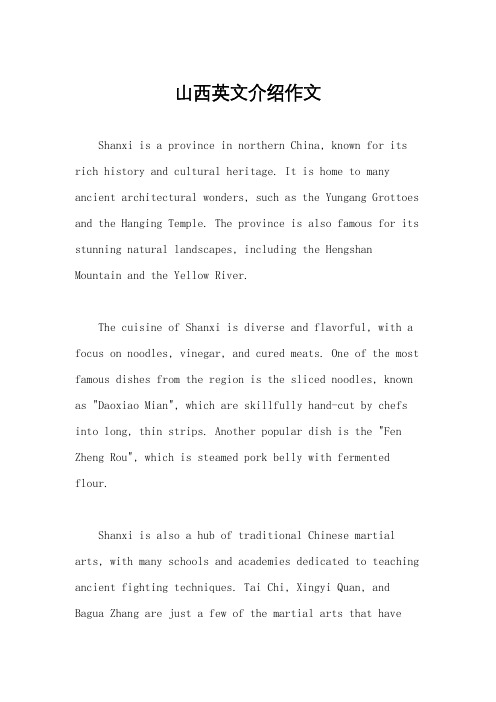
山西英文介绍作文Shanxi is a province in northern China, known for its rich history and cultural heritage. It is home to many ancient architectural wonders, such as the Yungang Grottoes and the Hanging Temple. The province is also famous for its stunning natural landscapes, including the Hengshan Mountain and the Yellow River.The cuisine of Shanxi is diverse and flavorful, with a focus on noodles, vinegar, and cured meats. One of the most famous dishes from the region is the sliced noodles, known as "Daoxiao Mian", which are skillfully hand-cut by chefs into long, thin strips. Another popular dish is the "Fen Zheng Rou", which is steamed pork belly with fermented flour.Shanxi is also a hub of traditional Chinese martial arts, with many schools and academies dedicated to teaching ancient fighting techniques. Tai Chi, Xingyi Quan, and Bagua Zhang are just a few of the martial arts that havebeen passed down through generations in Shanxi.In addition to its cultural and culinary offerings, Shanxi is also a major industrial center in China, with a strong focus on coal mining, energy production, and heavy machinery manufacturing. The province has made significant contributions to China's economic development and continues to be an important player in the country's industrial landscape.Overall, Shanxi is a fascinating destination thatoffers a unique blend of history, culture, and natural beauty. Whether you're interested in exploring ancient landmarks, savoring delicious cuisine, or delving into the world of martial arts, Shanxi has something to offer for every traveler.。
英文介绍老陈醋的作文
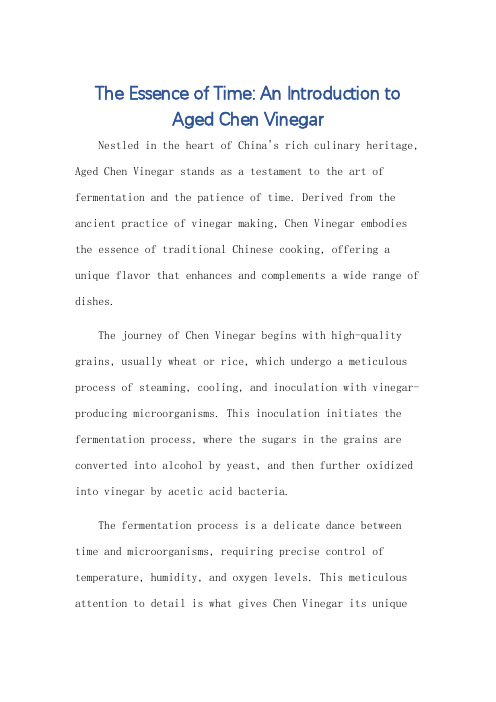
The Essence of Time: An Introduction toAged Chen VinegarNestled in the heart of China's rich culinary heritage, Aged Chen Vinegar stands as a testament to the art of fermentation and the patience of time. Derived from the ancient practice of vinegar making, Chen Vinegar embodies the essence of traditional Chinese cooking, offering a unique flavor that enhances and complements a wide range of dishes.The journey of Chen Vinegar begins with high-quality grains, usually wheat or rice, which undergo a meticulous process of steaming, cooling, and inoculation with vinegar-producing microorganisms. This inoculation initiates the fermentation process, where the sugars in the grains are converted into alcohol by yeast, and then further oxidized into vinegar by acetic acid bacteria.The fermentation process is a delicate dance between time and microorganisms, requiring precise control of temperature, humidity, and oxygen levels. This meticulous attention to detail is what gives Chen Vinegar its uniqueflavor profile, characterized by a rich, mellow taste with hints of sweetness and a lingering, complex aroma.As the vinegar ages, it undergoes a transformation that deepens its flavor and enhances its complexity. The process of aging, often spanning months or even years, allows the vinegar to develop a more rounded, balanced taste, rich in amino acids and other compounds that contribute to its unique umami quality.In Chinese cooking, Aged Chen Vinegar is used as both a seasoning and a preservative, adding a deep, satisfying flavor to dishes like pickled vegetables, marinated meats, and even soups and stews. Its ability to balance sweet, sour, salty, and bitter flavors makes it an indispensable ingredient in many Chinese kitchens.Beyond its culinary applications, Aged Chen Vinegar holds significant cultural and historical value. Its production methods, often passed down through generations of families, are a testament to the wisdom and craftsmanship of traditional Chinese fermentation techniques. Its use in various rituals and celebrationsfurther illustrates its deep connection to Chinese culture and lifestyle.In conclusion, Aged Chen Vinegar is not just a condiment; it is a testament to the art of fermentation, the patience of time, and the rich cultural heritage of Chinese cuisine. Its unique flavor and diverse applications make it an essential component of not only Chinese cooking but also the global palette of flavors.**老陈醋的精髓:一种陈年醋的介绍**在老中国丰富的烹饪遗产中,老陈醋以其独特的地位证明了发酵的艺术和时间的耐心。
我山西家乡的美食英文介绍
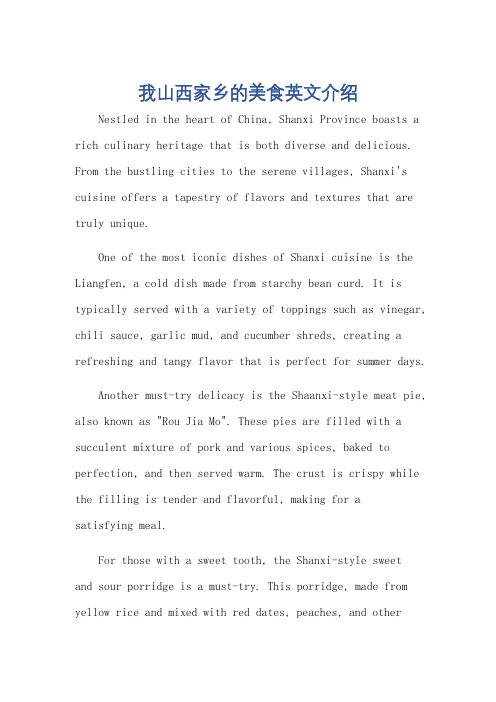
我山西家乡的美食英文介绍Nestled in the heart of China, Shanxi Province boasts a rich culinary heritage that is both diverse and delicious. From the bustling cities to the serene villages, Shanxi's cuisine offers a tapestry of flavors and textures that are truly unique.One of the most iconic dishes of Shanxi cuisine is the Liangfen, a cold dish made from starchy bean curd. It is typically served with a variety of toppings such as vinegar, chili sauce, garlic mud, and cucumber shreds, creating a refreshing and tangy flavor that is perfect for summer days. Another must-try delicacy is the Shaanxi-style meat pie, also known as "Rou Jia Mo". These pies are filled with a succulent mixture of pork and various spices, baked to perfection, and then served warm. The crust is crispy while the filling is tender and flavorful, making for asatisfying meal.For those with a sweet tooth, the Shanxi-style sweetand sour porridge is a must-try. This porridge, made from yellow rice and mixed with red dates, peaches, and otherfruits, is cooked to a creamy consistency and sweetenedwith sugar. The sourness comes from the addition of vinegar, creating a unique and refreshing flavor combination.Of course, no discussion of Shanxi cuisine is complete without mentioning the famous Shanxi noodles. These noodles, made from wheat flour, are available in a variety of shapes and sizes, each with its own unique flavor and texture. Whether it's the smooth and silky hand-pulled noodles orthe chunky and chewy knife-cut noodles, they are always served with a rich and flavorful broth, making for a comforting meal.But the beauty of Shanxi cuisine lies not just in its main dishes, but also in its side dishes and snacks. Fromthe crispy and savory fried dumplings to the hearty and satisfying stewed pork belly, from the refreshing and healthy vegetable salads to the indulgent and decadentsweet pastries, Shanxi cuisine has something for every palate.What truly sets Shanxi cuisine apart is its emphasis on balance and harmony. The use of fresh, local ingredients, combined with traditional cooking techniques, ensures thatevery dish is not only delicious but also nutritious. The blend of sweet, sour, salty, and spicy flavors creates a harmonious experience that leaves diners satisfied and delighted.In conclusion, Shanxi cuisine is a delicious blend of traditional flavors and cooking techniques that is sure to tantalize the taste buds of any food lover. From the rich and savory main dishes to the refreshing and indulgent desserts, there is something for everyone to enjoy. So if you're ever in Shanxi, make sure to sample its unique and delicious cuisine – you won't be disappointed!**山西美食:风味独特,令人难忘**山西,位于中国的心脏地带,拥有丰富的烹饪遗产,既多元又美味。
介绍山西美食英文作文
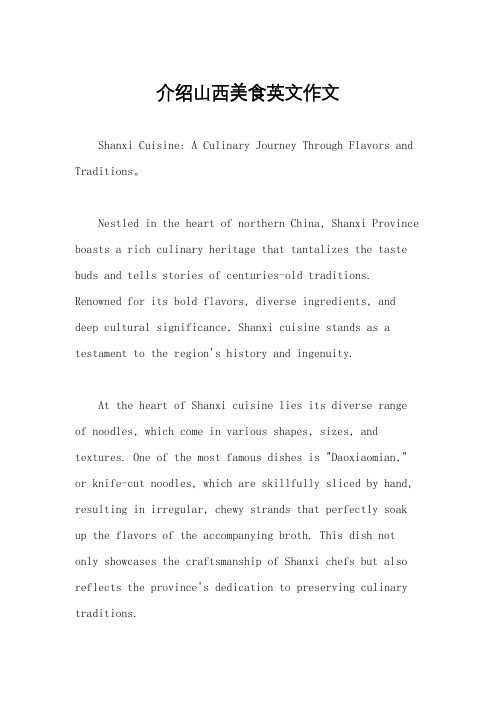
介绍山西美食英文作文Shanxi Cuisine: A Culinary Journey Through Flavors and Traditions。
Nestled in the heart of northern China, Shanxi Province boasts a rich culinary heritage that tantalizes the taste buds and tells stories of centuries-old traditions. Renowned for its bold flavors, diverse ingredients, and deep cultural significance, Shanxi cuisine stands as a testament to the region's history and ingenuity.At the heart of Shanxi cuisine lies its diverse range of noodles, which come in various shapes, sizes, and textures. One of the most famous dishes is "Daoxiaomian," or knife-cut noodles, which are skillfully sliced by hand, resulting in irregular, chewy strands that perfectly soak up the flavors of the accompanying broth. This dish not only showcases the craftsmanship of Shanxi chefs but also reflects the province's dedication to preserving culinary traditions.In addition to noodles, Shanxi cuisine is celebratedfor its savory pastries, with "Goubuli Baozi" being a standout example. These steamed buns, filled with succulent pork and a fragrant blend of spices, are a beloved snack enjoyed by locals and tourists alike. Legend has it that the name "Goubuli," meaning "dog ignores," originated from the tale of a busy restaurant where even the dogs outside would ignore the aroma emanating from within, as they were too absorbed in their own affairs.No exploration of Shanxi cuisine would be complete without mentioning its iconic vinegar. Made from locally sourced sorghum and aged in earthenware jars, Shanxi vinegar boasts a complex flavor profile that balances sweetness, tartness, and a hint of umami. Used in various dishes, from braised meats to dipping sauces, Shanxi vinegar adds depth and character to every bite, earning its place as a cornerstone of the province's culinary identity.Furthermore, Shanxi cuisine showcases a reverence for seasonal ingredients and sustainable practices. From heartystews featuring locally sourced vegetables to delicatestir-fries highlighting the bounty of the region's fertile plains, Shanxi chefs prioritize freshness and quality in every dish they create. This commitment to seasonal eating not only ensures optimal flavor but also fosters a deeper connection to the land and its agricultural rhythms.Beyond its delectable flavors, Shanxi cuisine is deeply intertwined with the region's cultural heritage. Many dishes carry symbolic meanings, such as "Jin Shuijiao," or Jin dumplings, which are traditionally served during the Spring Festival to signify prosperity and reunion. Similarly, "Liangfen," a cold jelly made from mung bean starch, is believed to bring good luck and ward off evil spirits when consumed during the hot summer months.In conclusion, Shanxi cuisine offers a captivating journey through flavors, traditions, and stories that have endured for generations. From hand-cut noodles to savory pastries, each dish reflects the province's rich history and unwavering commitment to culinary excellence. Whether savoring a bowl of steaming hot soup or indulging in aplate of crispy fried delicacies, experiencing Shanxi cuisine is an adventure for the senses that leaves a lasting impression on all who partake.。
英文介绍老陈醋的作文
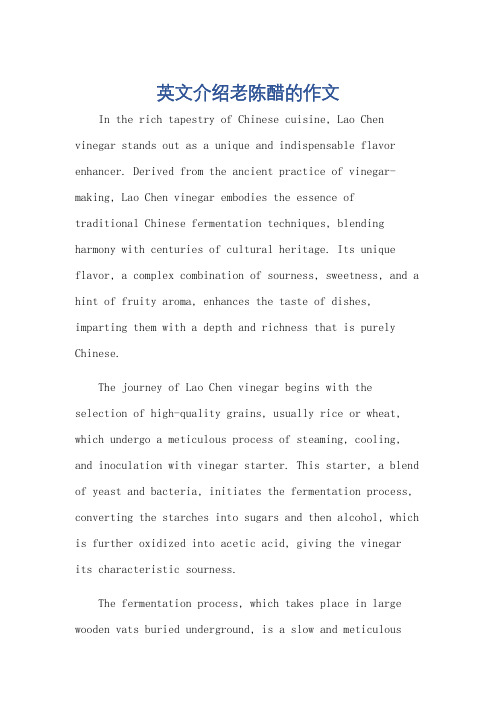
英文介绍老陈醋的作文In the rich tapestry of Chinese cuisine, Lao Chen vinegar stands out as a unique and indispensable flavor enhancer. Derived from the ancient practice of vinegar-making, Lao Chen vinegar embodies the essence oftraditional Chinese fermentation techniques, blending harmony with centuries of cultural heritage. Its unique flavor, a complex combination of sourness, sweetness, and a hint of fruity aroma, enhances the taste of dishes, imparting them with a depth and richness that is purely Chinese.The journey of Lao Chen vinegar begins with the selection of high-quality grains, usually rice or wheat, which undergo a meticulous process of steaming, cooling, and inoculation with vinegar starter. This starter, a blend of yeast and bacteria, initiates the fermentation process, converting the starches into sugars and then alcohol, which is further oxidized into acetic acid, giving the vinegarits characteristic sourness.The fermentation process, which takes place in large wooden vats buried underground, is a slow and meticulousone, often lasting for months or even years. This allowsfor the development of complex flavors and the unique aging process that gives Lao Chen vinegar its distinctive taste. The wooden vats, with their porous nature, allow for the natural filtration of the vinegar, imparting it with a hint of sweetness and a smooth texture.The aging process is crucial to the development of Lao Chen vinegar's flavor profile. As the vinegar matures, it absorbs the natural flavors and aromas from its surroundings, creating a unique and complex taste that is deeply rooted in the soil and climate of its origin. This aging process also ensures that the vinegar maintains its freshness and quality over time, making it a prized possession in Chinese households.In the kitchen, Lao Chen vinegar is a versatile ingredient, often used in marinades, dressings, andpickling recipes. Its unique flavor enhances the taste of meats, vegetables, and seafood, bringing out their natural flavors and adding a layer of complexity that is truly Chinese. From the tender meat of a Peking duck to the crispy skin of a fish, Lao Chen vinegar adds a subtle yetpowerful punch that elevates any dish to a culinary masterpiece.Moreover, Lao Chen vinegar's health benefits are numerous. It is rich in amino acids, vitamins, and minerals, all of which contribute to maintaining good health. Its antibacterial and antioxidant properties make it a natural preservative and a great addition to any healthy diet.In conclusion, Lao Chen vinegar is not just a flavor enhancer; it is a cultural icon that represents the rich history and heritage of Chinese cuisine. Its unique flavor, crafted through centuries of tradition and innovation, continues to inspire chefs and home cooks alike, creating delicious and nutritious dishes that are trulyrepresentative of the Chinese culinary art.**老陈醋的魅力:东方美食的精髓**在中国丰富多彩的菜肴中,老陈醋以其独特而不可或缺的风味增强剂身份脱颖而出。
用英文介绍自已的家乡山西作文
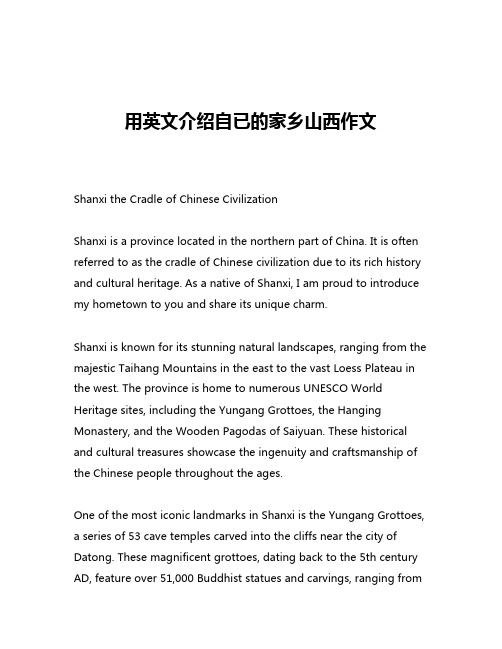
用英文介绍自已的家乡山西作文Shanxi the Cradle of Chinese CivilizationShanxi is a province located in the northern part of China. It is often referred to as the cradle of Chinese civilization due to its rich history and cultural heritage. As a native of Shanxi, I am proud to introduce my hometown to you and share its unique charm.Shanxi is known for its stunning natural landscapes, ranging from the majestic Taihang Mountains in the east to the vast Loess Plateau in the west. The province is home to numerous UNESCO World Heritage sites, including the Yungang Grottoes, the Hanging Monastery, and the Wooden Pagodas of Saiyuan. These historical and cultural treasures showcase the ingenuity and craftsmanship of the Chinese people throughout the ages.One of the most iconic landmarks in Shanxi is the Yungang Grottoes, a series of 53 cave temples carved into the cliffs near the city of Datong. These magnificent grottoes, dating back to the 5th century AD, feature over 51,000 Buddhist statues and carvings, ranging fromsmall figurines to towering 15-meter-tall sculptures. The intricate designs and attention to detail in these grottoes are a testament to the skill and artistry of the ancient Chinese sculptors.Another must-see destination in Shanxi is the Hanging Monastery, which is a remarkable feat of engineering and architectural design. The monastery is precariously perched on the side of a cliff, seemingly defying gravity with its wooden structures and stone foundations. The monastery's unique location and the harmonious blend of Buddhist, Taoist, and Confucian elements make it a truly awe-inspiring sight.Shanxi is also renowned for its well-preserved ancient cities, such as Pingyao and Datong. Pingyao, a UNESCO World Heritage site, is a remarkably intact ancient walled city that dates back to the Ming Dynasty. Wandering through its narrow streets and alleys, visitors can immerse themselves in the rich history and traditional architecture of this historic town.Datong, on the other hand, is known for its impressive city walls, dating back to the Northern Wei Dynasty. The city's most famous landmark is the Yungang Grottoes, but it also boasts the Hanging Monastery and the Wooden Pagodas of Saiyuan, another UNESCO World Heritage site. These pagodas, built in the 11th century, are some of the oldest and most well-preserved wooden structures inChina.Beyond its historical and cultural attractions, Shanxi is also renowned for its natural beauty. The Taihang Mountains, which stretch along the eastern edge of the province, offer breathtaking vistas and numerous hiking opportunities. The Loess Plateau, meanwhile, is a vast expanse of rolling hills and valleys covered in a thick layer of loess soil, creating a unique and picturesque landscape.One of the most popular outdoor destinations in Shanxi is the Yunmeng Gorge, a stunning natural wonder located in the Taihang Mountains. The gorge features towering cliffs, crystal-clear streams, and lush vegetation, making it a popular spot for hiking, camping, and outdoor recreation.Another natural gem in Shanxi is the Wutai Mountains, a sacred Buddhist site that is home to numerous temples, monasteries, and stunning landscapes. The five main peaks of the Wutai Mountains are believed to be the abode of the Bodhisattva Manjushri, and the area has been a popular pilgrimage site for Buddhists for centuries.Shanxi is also renowned for its rich culinary traditions, which have been influenced by its diverse cultural heritage. The province is famous for its delicious noodle dishes, such as the hand-pulled "knife-shaved" noodles and the thick, chewy "liang pi" noodles.Shanxi is also known for its flavorful meat dishes, such as the succulent "Shanxi-style braised pork" and the spicy "Shanxi-style lamb skewers."In addition to its culinary delights, Shanxi is also home to a thriving arts and crafts scene. The province is particularly famous for its intricate woodcarving, with artisans creating stunning sculptures, furniture, and architectural elements. The city of Pingyao is especially well-known for its traditional woodcarving, with many local artisans continuing to practice this centuries-old craft.Overall, Shanxi is a province that is rich in history, culture, and natural beauty. From its UNESCO World Heritage sites to its stunning natural landscapes, Shanxi offers a wealth of experiences for visitors to explore and discover. Whether you're interested in history, culture, or outdoor adventure, Shanxi has something to captivate and inspire you. As a native of this remarkable province, I am proud to share its unique charm and invite you to come and experience it for yourself.。
介绍山西美食的英语作文模板
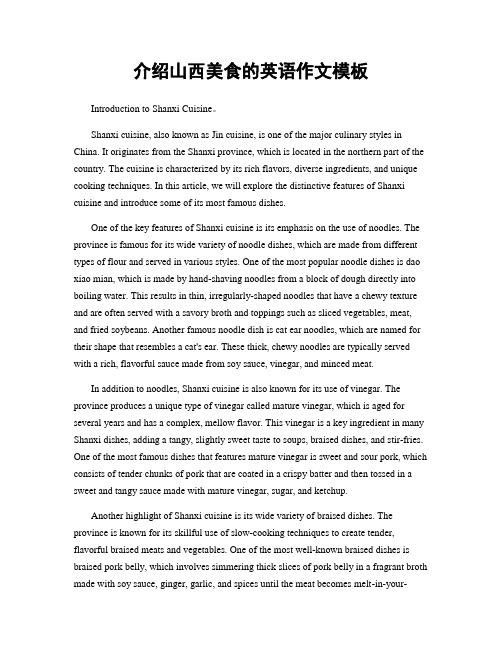
介绍山西美食的英语作文模板Introduction to Shanxi Cuisine。
Shanxi cuisine, also known as Jin cuisine, is one of the major culinary styles in China. It originates from the Shanxi province, which is located in the northern part of the country. The cuisine is characterized by its rich flavors, diverse ingredients, and unique cooking techniques. In this article, we will explore the distinctive features of Shanxi cuisine and introduce some of its most famous dishes.One of the key features of Shanxi cuisine is its emphasis on the use of noodles. The province is famous for its wide variety of noodle dishes, which are made from different types of flour and served in various styles. One of the most popular noodle dishes is dao xiao mian, which is made by hand-shaving noodles from a block of dough directly into boiling water. This results in thin, irregularly-shaped noodles that have a chewy texture and are often served with a savory broth and toppings such as sliced vegetables, meat, and fried soybeans. Another famous noodle dish is cat ear noodles, which are named for their shape that resembles a cat's ear. These thick, chewy noodles are typically served with a rich, flavorful sauce made from soy sauce, vinegar, and minced meat.In addition to noodles, Shanxi cuisine is also known for its use of vinegar. The province produces a unique type of vinegar called mature vinegar, which is aged for several years and has a complex, mellow flavor. This vinegar is a key ingredient in many Shanxi dishes, adding a tangy, slightly sweet taste to soups, braised dishes, and stir-fries. One of the most famous dishes that features mature vinegar is sweet and sour pork, which consists of tender chunks of pork that are coated in a crispy batter and then tossed in a sweet and tangy sauce made with mature vinegar, sugar, and ketchup.Another highlight of Shanxi cuisine is its wide variety of braised dishes. The province is known for its skillful use of slow-cooking techniques to create tender, flavorful braised meats and vegetables. One of the most well-known braised dishes is braised pork belly, which involves simmering thick slices of pork belly in a fragrant broth made with soy sauce, ginger, garlic, and spices until the meat becomes melt-in-your-mouth tender. The dish is often served with steamed buns or rice to soak up the rich, savory sauce.Lastly, Shanxi cuisine is also renowned for its steamed dumplings. The province is home to a diverse range of dumpling varieties, each with its own unique filling and shape. One of the most popular types is the five-spice beef dumplings, which are filled with a savory mixture of minced beef, scallions, and aromatic spices such as star anise, cinnamon, and Sichuan peppercorns. These dumplings are then steamed until the filling becomes juicy and flavorful, and they are typically served with a dipping sauce made from soy sauce, vinegar, and chili oil.In conclusion, Shanxi cuisine is a rich and diverse culinary tradition that showcases the province's unique ingredients and cooking techniques. From hand-shaved noodles to tangy vinegar-based dishes, from slow-cooked braised meats to flavorful steamed dumplings, the cuisine offers a wide range of flavors and textures that are sure to delight food enthusiasts. Whether you are a fan of noodles, vinegar, braised dishes, or dumplings, Shanxi cuisine has something to offer for everyone. So, if you ever have the chance to visit the Shanxi province, be sure to sample some of its delicious and authentic dishes.。
剪不断家乡情——山西老陈醋英文介绍

Selection of high-quality sorghum, barley, peas and corn
Products
• Shanxi aged vinegar is one of China's four famous vinegar, it has been 3000 years of history, known as "the best in all the land of vinegar" reputation, in color, fragrance, alcohol, acid concentration, five characteristics known the world.
• With the development of the times, the people of Shanxi are also constantly innovate vinegar culture
• A vinegar beverage:
• By the water, rock sugar, perfume and apple cider vinegar
Shanxi aged vinegar 山西老陈醋
China's Time-பைடு நூலகம்onored Brand
How much do you know the shanxi province?
Shanxi coal
boss? 山西煤老板?
•S
Shanxi aged vinegar 山西老陈醋
Do you know how to get it?
我为家乡带货英语作文醋
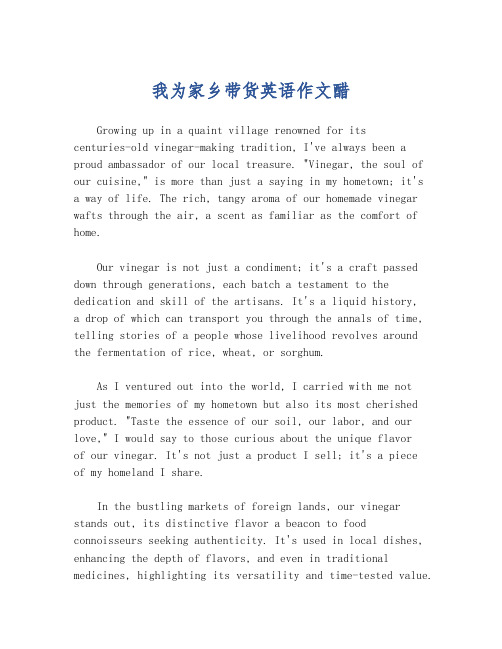
我为家乡带货英语作文醋Growing up in a quaint village renowned for itscenturies-old vinegar-making tradition, I've always been a proud ambassador of our local treasure. "Vinegar, the soul of our cuisine," is more than just a saying in my hometown; it's a way of life. The rich, tangy aroma of our homemade vinegar wafts through the air, a scent as familiar as the comfort of home.Our vinegar is not just a condiment; it's a craft passed down through generations, each batch a testament to the dedication and skill of the artisans. It's a liquid history,a drop of which can transport you through the annals of time, telling stories of a people whose livelihood revolves around the fermentation of rice, wheat, or sorghum.As I ventured out into the world, I carried with me notjust the memories of my hometown but also its most cherished product. "Taste the essence of our soil, our labor, and our love," I would say to those curious about the unique flavorof our vinegar. It's not just a product I sell; it's a pieceof my homeland I share.In the bustling markets of foreign lands, our vinegar stands out, its distinctive flavor a beacon to food connoisseurs seeking authenticity. It's used in local dishes, enhancing the depth of flavors, and even in traditional medicines, highlighting its versatility and time-tested value.Promoting our vinegar is more than just a commercial endeavor; it's a cultural exchange. It's about connecting people through the universal language of food and the stories it carries. As I continue to "bring goods from my hometown,"I do so with the hope of not only supporting my community but also enriching the culinary experiences of those who encounter our vinegar. It's a small bottle with a big mission—to bridge distances, to share heritage, and to create a legacy that transcends borders.。
山西特产介绍作文 英文
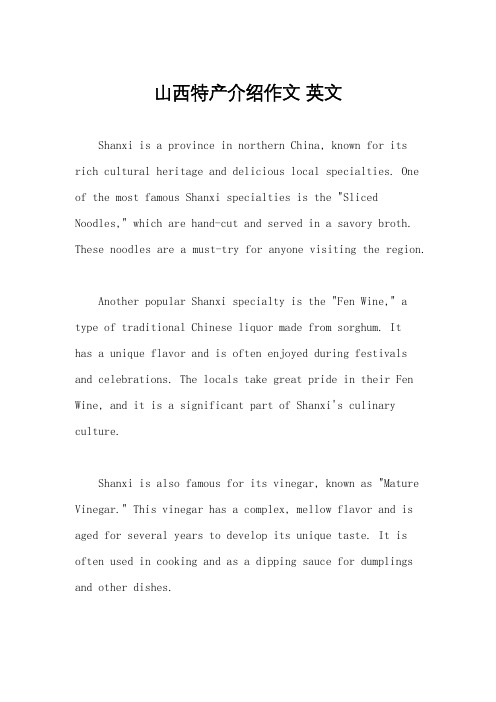
山西特产介绍作文英文Shanxi is a province in northern China, known for its rich cultural heritage and delicious local specialties. One of the most famous Shanxi specialties is the "Sliced Noodles," which are hand-cut and served in a savory broth. These noodles are a must-try for anyone visiting the region.Another popular Shanxi specialty is the "Fen Wine," a type of traditional Chinese liquor made from sorghum. Ithas a unique flavor and is often enjoyed during festivals and celebrations. The locals take great pride in their Fen Wine, and it is a significant part of Shanxi's culinary culture.Shanxi is also famous for its vinegar, known as "Mature Vinegar." This vinegar has a complex, mellow flavor and is aged for several years to develop its unique taste. It is often used in cooking and as a dipping sauce for dumplings and other dishes.One of the most unique Shanxi specialties is the "Cat Ear Noodles," which are shaped like cat ears and served in a hearty soup. These noodles are a beloved comfort food in the region and are often enjoyed with pickled vegetables and chili oil.In addition to these culinary delights, Shanxi is also known for its beautiful hand-painted paper cuts, intricate embroidery, and vibrant opera performances. The province's rich cultural heritage and delicious specialties make it a must-visit destination for anyone interested in experiencing the best of northern Chinese cuisine and traditions.。
山西美食英文介绍
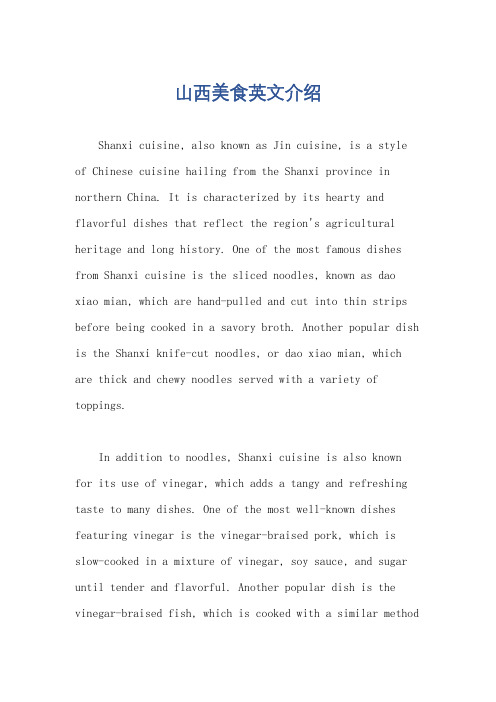
山西美食英文介绍Shanxi cuisine, also known as Jin cuisine, is a style of Chinese cuisine hailing from the Shanxi province in northern China. It is characterized by its hearty and flavorful dishes that reflect the region's agricultural heritage and long history. One of the most famous dishes from Shanxi cuisine is the sliced noodles, known as dao xiao mian, which are hand-pulled and cut into thin strips before being cooked in a savory broth. Another popular dish is the Shanxi knife-cut noodles, or dao xiao mian, which are thick and chewy noodles served with a variety of toppings.In addition to noodles, Shanxi cuisine is also knownfor its use of vinegar, which adds a tangy and refreshing taste to many dishes. One of the most well-known dishes featuring vinegar is the vinegar-braised pork, which is slow-cooked in a mixture of vinegar, soy sauce, and sugar until tender and flavorful. Another popular dish is the vinegar-braised fish, which is cooked with a similar methodand is often served with pickled vegetables to balance out the richness of the fish.Shanxi cuisine also features a variety of dumplings, including the famous cat ear dumplings, or mao er duo, which are shaped like cat ears and filled with a savory mixture of meat and vegetables. These dumplings are often served in a clear broth and are a comforting and satisfying meal. Another popular dumpling dish is the fried dumplings, which are crispy on the outside and juicy on the inside, making them a favorite among locals and visitors alike.One of the most unique aspects of Shanxi cuisine is its use of aged vinegar, which is made from fermented sorghum and has a complex and rich flavor. This vinegar is often used in marinades, sauces, and dressings to add depth and complexity to dishes. Another key ingredient in Shanxi cuisine is the use of locally-grown wheat, which is used to make noodles, dumplings, and steamed buns that are a staple in the region's diet.Overall, Shanxi cuisine is a delicious and diversestyle of Chinese cuisine that showcases the region's rich culinary traditions and agricultural bounty. From hearty noodle dishes to tangy vinegar-braised meats, there is something for everyone to enjoy in this unique andflavorful cuisine. Whether you are a fan of noodles, dumplings, or savory braised dishes, Shanxi cuisine has something to offer for every palate. So next time you find yourself in northern China, be sure to sample some of the delicious and satisfying dishes that Shanxi cuisine has to offer.。
介绍山西特产英语作文
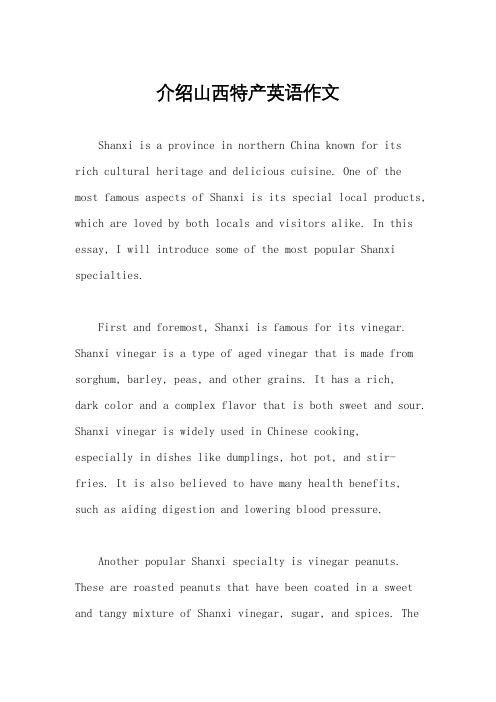
介绍山西特产英语作文Shanxi is a province in northern China known for itsrich cultural heritage and delicious cuisine. One of the most famous aspects of Shanxi is its special local products, which are loved by both locals and visitors alike. In this essay, I will introduce some of the most popular Shanxi specialties.First and foremost, Shanxi is famous for its vinegar. Shanxi vinegar is a type of aged vinegar that is made from sorghum, barley, peas, and other grains. It has a rich,dark color and a complex flavor that is both sweet and sour. Shanxi vinegar is widely used in Chinese cooking,especially in dishes like dumplings, hot pot, and stir-fries. It is also believed to have many health benefits, such as aiding digestion and lowering blood pressure.Another popular Shanxi specialty is vinegar peanuts. These are roasted peanuts that have been coated in a sweet and tangy mixture of Shanxi vinegar, sugar, and spices. Theresult is a crunchy, flavorful snack that is perfect for munching on while watching TV or enjoying a picnic. Vinegar peanuts are a favorite among locals and are often given as gifts during the Chinese New Year.In addition to vinegar, Shanxi is also known for its cured meats. One of the most famous cured meats from Shanxi is Laoyou, which is a type of dry-cured pork that is seasoned with salt, sugar, and spices. Laoyou has a rich, savory flavor and a tender texture that melts in your mouth. It is often sliced thinly and served as a snack or used asa topping for noodles and rice dishes.Finally, no discussion of Shanxi specialties would be complete without mentioning its noodles. Shanxi noodles are a type of hand-pulled noodle that is made from wheat flour and water. They are known for their chewy texture andability to absorb the flavors of the broth or sauce theyare served with. Shanxi noodles are often served in asavory broth with vegetables, meat, and tofu, making them a hearty and satisfying meal.In conclusion, Shanxi is a treasure trove of delicious specialties that are sure to delight anyone who tries them. From tangy vinegar to savory cured meats to chewy noodles, Shanxi has something for everyone. So next time you find yourself in Shanxi, be sure to sample some of these local delights – you won't be disappointed!。
我为家乡带货300字英语作文山西
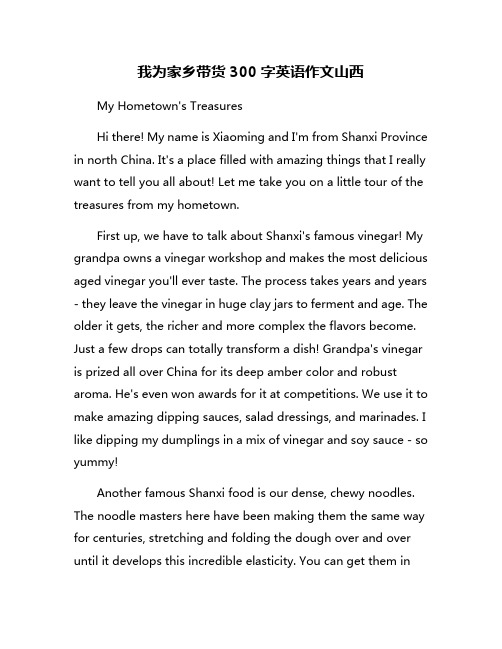
我为家乡带货300字英语作文山西My Hometown's TreasuresHi there! My name is Xiaoming and I'm from Shanxi Province in north China. It's a place filled with amazing things that I really want to tell you all about! Let me take you on a little tour of the treasures from my hometown.First up, we have to talk about Shanxi's famous vinegar! My grandpa owns a vinegar workshop and makes the most delicious aged vinegar you'll ever taste. The process takes years and years - they leave the vinegar in huge clay jars to ferment and age. The older it gets, the richer and more complex the flavors become. Just a few drops can totally transform a dish! Grandpa's vinegar is prized all over China for its deep amber color and robust aroma. He's even won awards for it at competitions. We use it to make amazing dipping sauces, salad dressings, and marinades. I like dipping my dumplings in a mix of vinegar and soy sauce - so yummy!Another famous Shanxi food is our dense, chewy noodles. The noodle masters here have been making them the same way for centuries, stretching and folding the dough over and over until it develops this incredible elasticity. You can get them insoup, stir-fries, or just tossed with some savory sauce. My favorite is the biangbiang noodles - they're as wide as a belt and have the most satisfying chew. Sometimes the noodle makers get really artistic and twist them into intricate shapes and patterns. It's like edible art!While we're on the topic of food, I have to mention Shanxi's mature vinegar pumpkins. These things are no ordinary pumpkins! They're carefully aged in vinegar for months until the insides become this rich, sticky, almost candied filling. It's sour, sweet and unbelievably delicious all at once. You can eat it straight out of the pumpkin or use it as a crazy flavorful glaze or dip. My auntie makes the most amazing vinegar pumpkin cookies - crispy on the outside but gooey and decadent in the middle. They're my absolute favorite treat.Then there are the Hanging Monastery and Yingxian Wooden Pagoda - two more amazing examples of Shanxi's ancient architecture that have been preserved for centuries. The Hanging Monastery is built directly into the side of a sheer cliff, suspended over a thousand feet in the air! It's made up of a series of pavilions and halls connected by walkways and bridges. Looking down makes my head spin, but the view is absolutely incredible. As for the Wooden Pagoda, it's one of the oldestall-wood pagodas in China at over 900 years old. What's crazy is that it was built entirely without using a single nail. The whole tower is intricately pieced together using special joints and brackets. Pretty mind-blowing if you ask me!I could honestly go on forever about all the treasures from Shanxi. We have the most beautiful jade carvings and ornaments. The famous Shanxi merchants who traveled all overChina in imperial times left us zhengji buildings with exquisite painted decorations on the walls and ceilings. Our local embroidery and paper cutting folk arts are renowned nationwide for their intricate patterns and craftsmanship. There's just so much history and culture packed into this province!Everywhere you look in Shanxi, there's something incredible to discover - whether it's a delicious century-old food recipe, an ancient architectural wonder, or a beautiful traditional craft. I feel so lucky to have grown up surrounded by all these amazing treasures. They make me incredibly proud of my hometown.To me, Shanxi embodies the saying "aged like a fine wine." The older our traditions and crafts get, the more precious and full of character they become. Kind of like my grandpa's aged vinegar! Promoting and protecting these treasures is so important. I really want to share them with the whole world soeveryone can experience and appreciate the magic of my home province.If you ever get the chance to visit Shanxi, you absolutely have to try the vinegar, noodles and vinegar pumpkins. And be sure to check out the Yungang Grottoes, Hanging Monastery and all the other incredible heritage sites we have here. Each one is a living museum, giving you a window into ancient China's rich history and culture. Let Shanxi's time-honored treasures dazzle and delight you! We'll be waiting with open arms to welcome you.。
介绍山西美食的英文作文
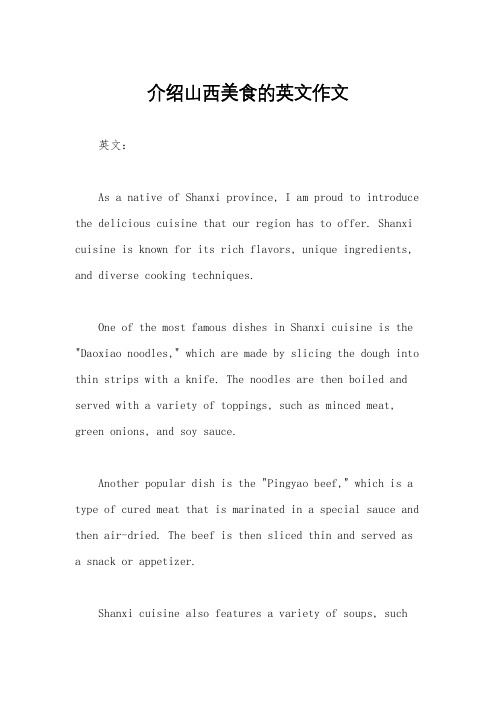
介绍山西美食的英文作文英文:As a native of Shanxi province, I am proud to introduce the delicious cuisine that our region has to offer. Shanxi cuisine is known for its rich flavors, unique ingredients, and diverse cooking techniques.One of the most famous dishes in Shanxi cuisine is the "Daoxiao noodles," which are made by slicing the dough into thin strips with a knife. The noodles are then boiled and served with a variety of toppings, such as minced meat, green onions, and soy sauce.Another popular dish is the "Pingyao beef," which is a type of cured meat that is marinated in a special sauce and then air-dried. The beef is then sliced thin and served as a snack or appetizer.Shanxi cuisine also features a variety of soups, suchas the "Liangpi" soup, which is made from cold noodles and a spicy sauce, and the "Gouzi soup," which is made from dumplings and a hearty broth.In addition to these dishes, Shanxi cuisine is also known for its desserts, such as the "Fenjiu jelly," which is made from the famous Shanxi liquor and agar-agar.Overall, Shanxi cuisine is a unique and delicious blend of flavors and ingredients that are sure to satisfy any food lover's taste buds.中文:作为山西人,我很自豪地介绍我们这个地区的美食。
关于山西老陈醋的英语作文
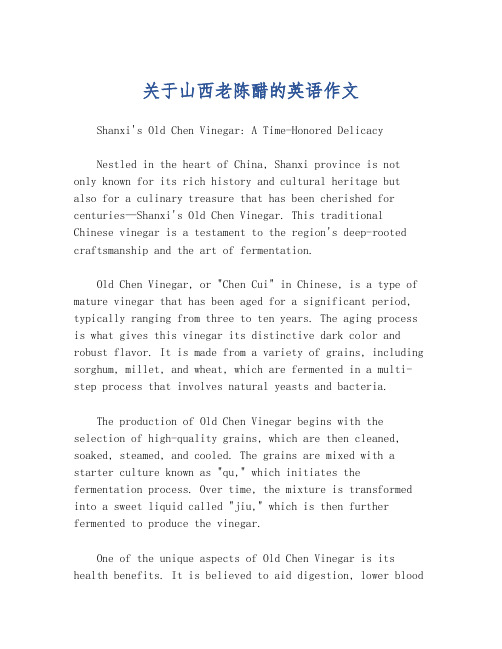
关于山西老陈醋的英语作文Shanxi's Old Chen Vinegar: A Time-Honored DelicacyNestled in the heart of China, Shanxi province is not only known for its rich history and cultural heritage but also for a culinary treasure that has been cherished for centuries—Shanxi's Old Chen Vinegar. This traditional Chinese vinegar is a testament to the region's deep-rooted craftsmanship and the art of fermentation.Old Chen Vinegar, or "Chen Cui" in Chinese, is a type of mature vinegar that has been aged for a significant period, typically ranging from three to ten years. The aging process is what gives this vinegar its distinctive dark color and robust flavor. It is made from a variety of grains, including sorghum, millet, and wheat, which are fermented in a multi-step process that involves natural yeasts and bacteria.The production of Old Chen Vinegar begins with the selection of high-quality grains, which are then cleaned, soaked, steamed, and cooled. The grains are mixed with a starter culture known as "qu," which initiates the fermentation process. Over time, the mixture is transformed into a sweet liquid called "jiu," which is then further fermented to produce the vinegar.One of the unique aspects of Old Chen Vinegar is its health benefits. It is believed to aid digestion, lower bloodpressure, and even enhance the immune system. The vinegar is also said to have antibacterial properties, making it anatural preservative.In the culinary world, Old Chen Vinegar is a versatile ingredient that adds a depth of flavor to a variety of dishes. It is used in the preparation of traditional Shanxi dishes such as "Shanxi Knife Cut Noodles" and "Shanxi Fried Dough Twists." Beyond its local cuisine, it is also a popular condiment in Chinese cooking, where it can be found in marinades, dressings, and sauces.The cultural significance of Old Chen Vinegar extends beyond the kitchen. It is often given as a gift duringspecial occasions, symbolizing prosperity and good health.The vinegar is also featured in local festivals, where it is celebrated for its contribution to the region's gastronomic identity.In conclusion, Shanxi's Old Chen Vinegar is more thanjust a condiment; it is a symbol of the region's history, culture, and culinary expertise. Its unique flavor profile, health benefits, and cultural importance make it a treasure worth savoring and sharing with the world. As the saying goes, "The older the chen vinegar, the better," and Shanxi's Old Chen Vinegar is a prime example of this adage.。
关于山西醋地区地理环境英语作文
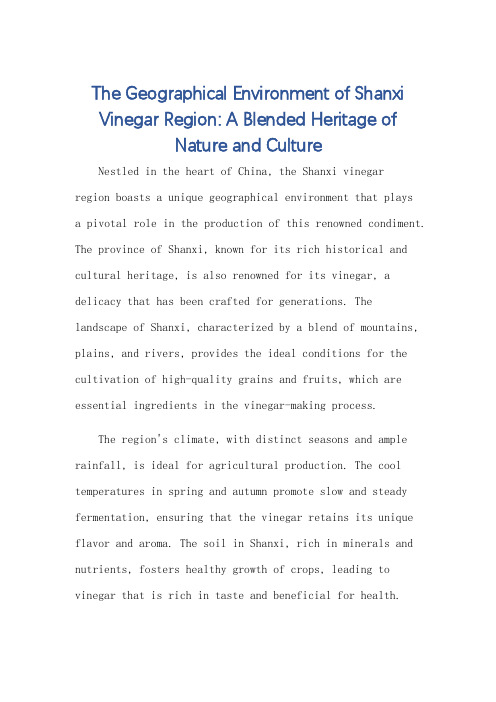
The Geographical Environment of ShanxiVinegar Region: A Blended Heritage ofNature and CultureNestled in the heart of China, the Shanxi vinegarregion boasts a unique geographical environment that playsa pivotal role in the production of this renowned condiment. The province of Shanxi, known for its rich historical and cultural heritage, is also renowned for its vinegar, a delicacy that has been crafted for generations. The landscape of Shanxi, characterized by a blend of mountains, plains, and rivers, provides the ideal conditions for the cultivation of high-quality grains and fruits, which are essential ingredients in the vinegar-making process.The region's climate, with distinct seasons and ample rainfall, is ideal for agricultural production. The cool temperatures in spring and autumn promote slow and steady fermentation, ensuring that the vinegar retains its unique flavor and aroma. The soil in Shanxi, rich in minerals and nutrients, fosters healthy growth of crops, leading to vinegar that is rich in taste and beneficial for health.The geographical location of Shanxi, situated between the Loess Plateau and the North China Plain, also contributes to the vinegar's unique character. The altitude and terrain of the region influence the microclimate, creating conditions that are conducive to the unique fermentation process of vinegar making. The traditional vinegar-making techniques, passed down through generations, are further enhanced by this natural environment.The people of Shanxi, with their deep-rooted respectfor nature and their ancestors' wisdom, have perfected the art of vinegar making. They carefully select the finest grains and fruits, allowing them to ferment naturally in harmony with the local climate and terrain. This symbiotic relationship between humans and nature has resulted in a vinegar that is not only a culinary delicacy but also a testament to the region's rich cultural heritage.The geographical environment of the Shanxi vinegar region is not just a physical landscape; it is a living, breathing entity that plays a crucial role in shaping the identity and flavor of this legendary vinegar. From thesoil that nurtures the crops to the air that carries thescent of fermentation, every element of this region contributes to the unique character of Shanxi vinegar.**山西醋地区的地理环境:自然与文化的融合遗产** 位于中国心脏地带的山西醋区,以其独特的地理环境在醋的生产中扮演着举足轻重的角色。
山西特产英文作文
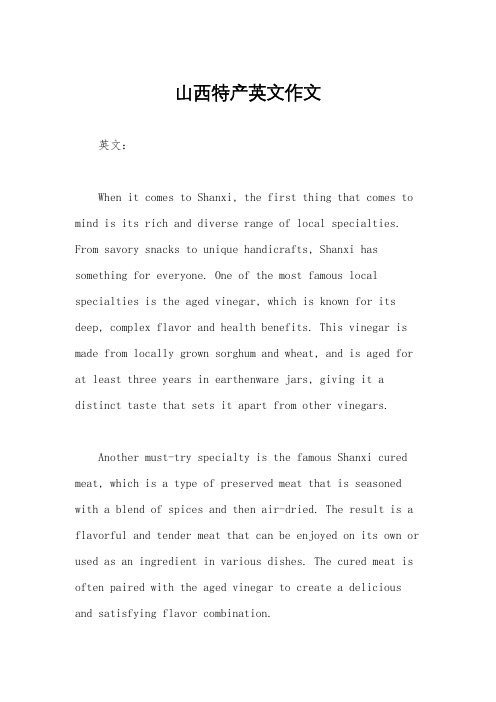
山西特产英文作文英文:When it comes to Shanxi, the first thing that comes to mind is its rich and diverse range of local specialties. From savory snacks to unique handicrafts, Shanxi has something for everyone. One of the most famous local specialties is the aged vinegar, which is known for its deep, complex flavor and health benefits. This vinegar is made from locally grown sorghum and wheat, and is aged for at least three years in earthenware jars, giving it a distinct taste that sets it apart from other vinegars.Another must-try specialty is the famous Shanxi cured meat, which is a type of preserved meat that is seasoned with a blend of spices and then air-dried. The result is a flavorful and tender meat that can be enjoyed on its own or used as an ingredient in various dishes. The cured meat is often paired with the aged vinegar to create a delicious and satisfying flavor combination.In addition to food specialties, Shanxi is also known for its beautiful hand-painted paper cuts, which are often used to decorate homes during festivals and celebrations. These intricate paper cuts are made by skilled artisans who use traditional techniques to create stunning designs that depict scenes from Chinese folklore and mythology. The paper cuts make for unique and meaningful souvenirs for visitors to take home.Shanxi is also famous for its traditional handicrafts, such as the hand-carved wooden furniture and the delicate embroidery that is often seen on clothing and accessories. These handicrafts showcase the skill and artistry of the local craftsmen, and are highly sought after by collectors and tourists alike.Overall, the local specialties of Shanxi are a testament to the rich cultural heritage of the region, and offer a unique and authentic experience for visitors. Whether it's the savory flavors of the aged vinegar and cured meat, or the intricate designs of the hand-paintedpaper cuts and traditional handicrafts, Shanxi has something special to offer to everyone.中文:提到山西,人们首先想到的就是其丰富多样的特产。
- 1、下载文档前请自行甄别文档内容的完整性,平台不提供额外的编辑、内容补充、找答案等附加服务。
- 2、"仅部分预览"的文档,不可在线预览部分如存在完整性等问题,可反馈申请退款(可完整预览的文档不适用该条件!)。
- 3、如文档侵犯您的权益,请联系客服反馈,我们会尽快为您处理(人工客服工作时间:9:00-18:30)。
Shanxi aged vinegar 山西老陈醋
China's Time-Honored Brand
How much do you know the shanxi province?
Shanxi coal
boss? 山西煤老板?
•S
Shanxi aged vinegar 山西老陈醋
Do you know how to get it?
Why Shanxi people like to eat
vinegar
One is the Shanxi water and soil is hard, vinegar can play a softening effect;
• the two is the Shanxi people like to eat all kinds of food, especially a variety of grains pasta, vinegar can help digestion.
Life is wonderful because of vinegar
• Government construction etown, you can see a village is vinegar and a lot of people because the vinegar
Production staff will be the raw material in the mixing, fermentation
Selection of high-quality sorghum, barley, peas and corn
Products
• Shanxi aged vinegar is one of China's four famous vinegar, it has been 3000 years of history, known as "the best in all the land of vinegar" reputation, in color, fragrance, alcohol, acid concentration, five characteristics known the world.
and the rich • As above, the first village of Shanxi vinegar, because a lot of people do vinegar become
millionaire
• Thank you to our Shanxi vinegar culture, hope you are free to come to Shanxi to have a look, a taste of Shanxi vinegar. Thank you.
• With the development of the times, the people of Shanxi are also constantly innovate vinegar culture
• A vinegar beverage:
• By the water, rock sugar, perfume and apple cider vinegar
